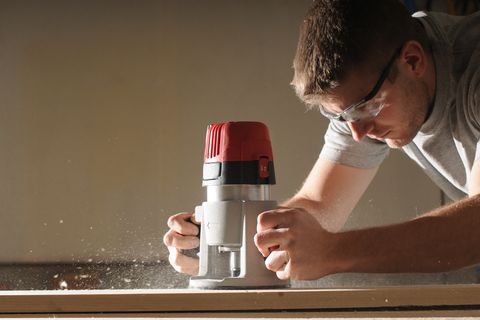5 Biggest Woodworking Mistakes (And How to Avoid Them)
Build it right the first time by avoiding these common mistakes.
By Roy Berendsohn
GETTY IMAGES/MSDERRICK
Woodworking (and carpentry) is one of humanity's oldest careers, but that doesn't mean we aren't still mucking it up now and then.
Here are a few common mistakes people make when entering the complicated-yet-rewarding world of woodworking, and how best to avoid them.
Mistake #1: The Wrong Blade

CMT
Some people keep one blade on their circular saw and they use it for everything. This is either the 18-tooth or 24-tooth combination blade that the saw came with (and it’s probably dull, too). These 18-tooth and 24-tooth stock blades are known as “framing blades,” and you use them for cutting framing lumber when building or remodeling a house.
You need not only a blade with finer teeth, but one designed for specific materials, like plywood. The teeth of this high-quality 40-tooth blade have both flat-top and alternate-top-bevel grind so the blade rips and crosscuts cleanly.
And if you want to go finer still, there's always this 60-tooth blade, or even this super-fine-cutting 140-tooth plywood blade.
Mistake #2: The Wrong Side Up
Cutting plywood can be tricky. Even after taking precautions against splintering (such as using the correct blade and putting masking tape along the cut line) you may experience some splintering.
When using a circular saw, always face the side that will be visible in the assembly facedown. This way, the circular saw’s teeth meet it first, and exit out the back of the panel. If any splintering occurs, it will occur there, on the back surface.
Just the opposite is true when using a table saw. You cut with the good face up.
Mistake #3: The Wrong Fastener

BOLT DROPPER
Using plain steel nails and screws outside is an invitation for corrosion, rust stains, and wood joints that fall apart. Use hot-dipped galvanized or stainless-steel nails and screws when fastening outdoors.
Mistake #4: The Wrong Glue
Wood glue comes in three basic varieties as far as its water resistance is concerned: standard, moisture-resistant, and waterproof. Use standard indoors, use moisture resistant indoors in damp environments or outdoors under cover, and use waterproof in areas where the wood assembly is fully exposed to the weather.
Mistake #5: The Wrong Way

GETTY IMAGES/YANIK88
People think that because a router spins its bit 360 degrees, it doesn’t matter which direction you move around the workpiece. Well, that’s sort of true. It will work in either direction but you can only get away with this so many times before the router grabs and tears when moving in the wrong direction.
The solution is that you go counterclockwise around the edge of a project, like a tabletop or frame. But if you’re routing the inside of the frame, you move in a clockwise direction. This little graphic from Kreg Tool and Woodsmith magazine is one of the best compact explanations anywhere around.
No comments:
Post a Comment